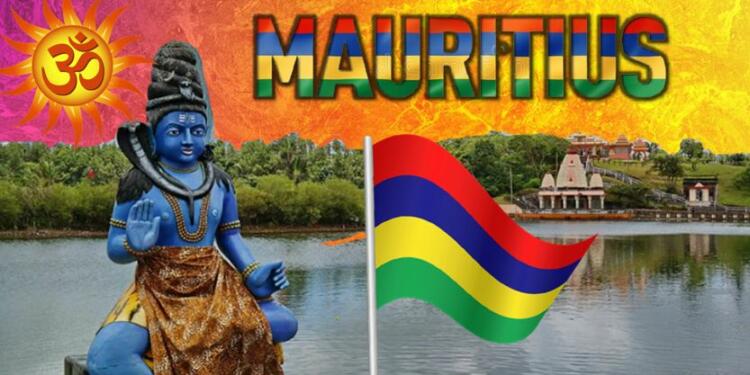Mauritius is a small island off the coast of Africa. What makes the country incredibly interesting is that it is the only country in Africa that is a Hindu majority state. 6,70,000 Hindus reside in the tiny, picturesque country which amounts to almost 50% of the total population. Meanwhile, one-third of the country (26.3%) identify as Roman Catholic, while 17.3% identify as Muslim.
The overwhelming presence of Hindus in a country, thousands of kilometers away from India, made Prime Minister Narendra Modi describe Mauritius as “Little India” during his 2015 trip to the country.
How did Indians reach Mauritius?
Akin to other countries with a sizeable Indian population, the Indo-Mauritians were brought to the African country by the British colonists, as part of the indentured labor system to work on their fields to grow cash crops.
Reportedly, between 1835 and 1907, an estimated 500,000 indentured labourers, two-thirds of which were Bhojpuri speaking natives from eastern Uttar Pradesh and Bihar, arrived in Mauritius.
While the practice was cruel, as was the norm at the time, the Hindus, as they usually do, made the foreign, alien conditions hospitable to call it home. However, after Mauritius gained independence in 1968, the political power of the country has been held by descendants of Indian indentured labourers.
Hindu customs, temples, and people:
The presence of Hindus also means that Mauritius is home to several spectacular temples. Maha Shivratri in Mauritius is celebrated like Ganesh Chaturthi in Mumbai, while Diwali is an official holiday in the country’s calendar.
Maheswarnath Shiv Mandir, Sagar Shiv Mandir, Pandurang Kshetra Mandir and Shri Prasanna Venkateswara Temple are a few of the most popular temples across the country that tourists and locals throng throughout the year. As a result, Mauritius and India have excellent bilateral relations and people to people ties.
Also read: Hindus in Mauritius have Made Hindus all over the World Proud
Named after river-goddess Ganga, a lake called Ganga Talao:
One of the famous places in Mauritius is the Ganga Talao, situated near the western boundaries of the island, atop the mountains. This crater lake is found in a secluded mountain area 1800 feet above sea level, and on Hindu festivals and special occasions, the lake lights up with Hindu rituals. The name of the lake derives inspiration from the mighty Ganga river in India.
There is a particularly intriguing story behind the origin of the Ganga Talao. According to popular folklore, a priest named Pandit Jhummon Giri Gossagne once saw a dream about a holy lake, that was connected to the Ganga.
The priest, convinced about the reality of his dreams, set out on a seemingly impossible journey of finding one such lake. After some time, he came across a lake amidst volcanic rocks, above 1800 ft sea level, situated in a picturesque location; he felt that this was the same lake he had dreamt of.
Food and speaking habits:
The food habits of the Mauritians are overarchingly similar to that of Indians due to obvious reasons. The Indian-inspired Mauritian curries are a big hit, while atta, maida (used mostly because it could be preserved by the labourers for longer periods) and lentils (dal) form part of a staple diet of the people.
Although Mauritius has no official language, Mauritius is the second most spoken language behind French-based Mauritian Creole. Meanwhile, English is used as a medium of instruction.
Ties between India and Mauritius:
Under current Mauritian Prime Minister Pravind Jugnauth and PM Modi, the ties between the two nations have only soared. Indians are extremely proud of the diplomacy extended to the Vanilla Islands, as it strengthens India’s naval position against China’s invasive and belligerent ambition in the Indian Ocean.
As reported by TFI, after Mauritius was put in the grey list of the Financial Action Task Force (FATF), it was India that stood beside it and helped the country get out of the doomed list by using its clout in the Paris-based watchdog.
Also read: Mauritius exits FATF grey list and India has its task cut out
It’s like a homecoming – S Jaishankar:
Reportedly, when External Affairs Minister S Jaishankar visited Mauritius earlier this year in February, Prime Minister Pravind Jugnauth remained thankful to the Indian government for its support and stated:
“Based on the respect for the rule of law, in that context, we reviewed the latest developments in respect of the completion of the decolonisation of Mauritius, a matter on which India has given its unflinching support right from the beginning of our struggle.”
In February, India signed a landmark Comprehensive Economic Cooperation and Partnership Agreement (CECPA) with Mauritius, the first of its kind with an African nation, making the strategically-located country a launch-pad for business expansion into the huge African continent.
At the time, S Jaishankar also remarked, “Every time I am here in your beautiful country, I realise how closely we are bound. To be amongst people like you, who continue to cherish and celebrate their Indian roots and traditions so vibrantly, this is actually a feeling which is very difficult to put in words,”
India and Mauritius are culturally alike and while the rise of fundamentalism has hurled few curveballs towards the Hindu inhabitants of the country, the African nation continues to thrive and contain its Hindu identity.































